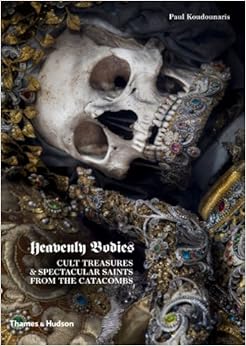 It wasn't entirely clear why this book was displayed so prominently in the shop at Two Temple Place in London the last time we went there, but it made it very tempting to buy, especially when I discovered it concerned a aspect of religious history I knew absolutely nothing about. Paul Koudounaris's previous sumptuous book, The Empire of Death, covered the various caches of human remains in catacombs and crypts around Europe and the elaborate means sometimes adopted to display them. The story behind Heavenly Bodies is different. In 1578 the authorities in Rome discovered the Catacombs there, the vast labyrinth of underground tombs in which much of the citizenry of the ancient city had been interred. Over the subsequent 200 years, many of these skeletons, assumed to be Christians and therefore martyrs and therefore saints, were disinterred, sent north to mainly German-speaking parts of Europe ravaged by religious conflict, and reassembled as cult objects, lavished with expensive decoration and much public affection and reverence. They became mute foot-soldiers in the Catholic Church's attempt to reconquer the hearts and minds of middle-Europeans.
It wasn't entirely clear why this book was displayed so prominently in the shop at Two Temple Place in London the last time we went there, but it made it very tempting to buy, especially when I discovered it concerned a aspect of religious history I knew absolutely nothing about. Paul Koudounaris's previous sumptuous book, The Empire of Death, covered the various caches of human remains in catacombs and crypts around Europe and the elaborate means sometimes adopted to display them. The story behind Heavenly Bodies is different. In 1578 the authorities in Rome discovered the Catacombs there, the vast labyrinth of underground tombs in which much of the citizenry of the ancient city had been interred. Over the subsequent 200 years, many of these skeletons, assumed to be Christians and therefore martyrs and therefore saints, were disinterred, sent north to mainly German-speaking parts of Europe ravaged by religious conflict, and reassembled as cult objects, lavished with expensive decoration and much public affection and reverence. They became mute foot-soldiers in the Catholic Church's attempt to reconquer the hearts and minds of middle-Europeans.Even at the time sceptical voices pointed out that the identification of many of these figures with saints was, let us say, a little optimistic. Despite the authentications sent out with the bodies from the office at the Vatican concerned with such matters, which detailed as much as could be gleaned about the life of whichever particular warrior of the Faith whose remains were being posted out to some small town in Bavaria or Austria - a lot of these saints are named things like Benedictus or Felicianus - it was not actually clear that the bones had belonged to people who were even Christians in life, let alone martyrs; not everyone buried in the Catacombs had been either. Notwithstanding the miracles they worked and the devotion they provoked, as the nineteenth century drew on the Catacomb Saints became something of an embarrassment, their insistently carnal presence felt to be a bit grotesque as well as dubious historically. Many disappeared, others were covered up or banished to obscure sacristies; only occasionally do they still remain in situ, reigning still from an altarpiece or shrine.
Clearly something for our Mission Planning Group to consider.

No comments:
Post a Comment